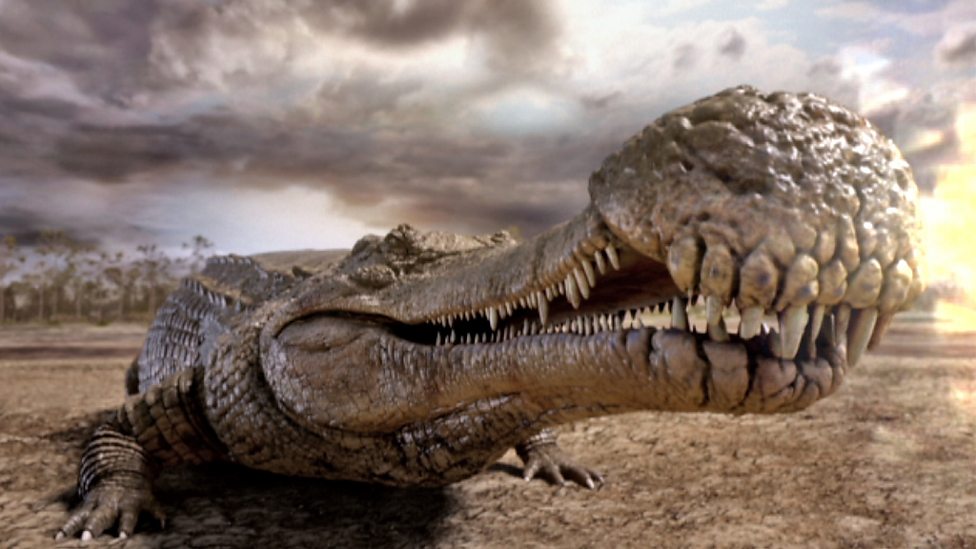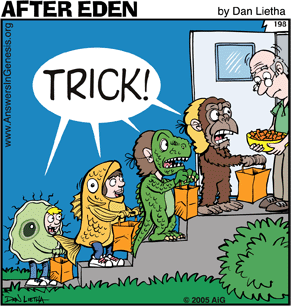 |
Seti the Sarcosuchus is the newest creature to come out of Dr. Steve's lab! Continue reading to learn about the surprising discoveries surrounding this creature. (Photo Credits)
|
Over the past several years, Dr. Steve Stevenson has cooked up some strange and bizarre creatures in his lab in the Animal Adventures Institute (AAI). Like in 2012, he brought the saber-toothed mammal-like reptile
Inostrancevia. I didn't even know there were other animals with saber-teeth other than the famous saber-toothed cats! Another instance was in 2014 when he and his assistants cloned the strange semi-aquatic fish-eating
Suchomimus. But all that pales in comparison with the creature accidentally released last Saturday!
It was a normal day (isn't that how most bizarre or really unusual days start?) in Animal Adventures Inc. when some loud noises were coming from AAI. Confused, my trusty, junior photographer, Daniel P. Smithwater, myself, Lizzy the Lizard, one of my reporters, and Jack the Jack Rabbit, our intern, and some other Animal Adventures Inc. residents headed over to the institute to find out what was going on in there! “We've heard strange noises coming from the institute before,” says resident vet Elizabeth Sorkin, “but nothing like we heard today!” We were shocked by what we found!
After reaching the building, the doors to the entrance were being hammered against by something inside, and it was big...really big. A few seconds later, the doors flung off their hinges and mist poured out of the lab as a large reptile came out into the open. With a long toothy snout, scaly hide and a long flexible tail, the creature we saw was a crocodile, but this was no ordinary crocodile: it was longer than a school bus! The crocodile released a loud intimidating bellow and Dr. Steve and his main assistant Oliver
Oviraptor followed the beast out so they could explain to everyone what just happened. When asked what was going on, Dr. Steve was quoted for saying, “We're sorry for the inconvenience everyone. He was a bit too determined to get out.” Later, he explained what this monster crocodile was: “He's a
Sarcosuchus imperator, meaning 'flesh crocodile emperor', and his name is Seti, after the ancient Egyptian pharaoh. Some people call
Sarcosuchus 'Super Croc', because of its size. I guess he really wanted to get out of the institute, so he barged out the door. He's one of the most powerful animals we've ever cloned in this facility.” Fortunately, Seti had been “tamed” so that he wouldn't start attacking people. I then asked him why Seti was released so early (Dr. Steve usually releases his animals from the hatchery sometime in December or January). He is quoted for saying, “It wasn't really up to us. For some strange reason...”(he glared at Oliver)“...it appears someone, and I'm not saying who, but someone fed Seti the wrong amounts of organic growth enhancers, allowing the animal to grow quicker and mature faster. Our other cloning projects haven't left their eggs yet!”
One of the residents present last week was Dr. Samuel Adamson, the company's chief paleontologist. He was astounded by this impressive beast. “I'm glad to see the
Sarcosuchus specimen we brought back not long ago contained usable
Sarcosuchus DNA,” he said. I asked the paleontologist what information he could give me about Sarcosuchus. He said, “
Sarcosuchus is the largest crocodile that ever existed and its fossils have been discovered in northern Africa. It lived in the world before Noah's Flood, about 4,350 years ago and grew over 40 feet long and weighed 8-10 tons! It's simply a huge beast! This crocodile lived in the same environment as many African dinosaurs that we've discovered; and unlike many of
Sarcosuchus' Cretaceous crocodilian cousins, it didn't walk with dinosaurs, it ate them! This was a reptile capable of taking down medium-sized dinosaurs!”
Seti the
Sarcosuchus was certainly an impressive creature, but there was something else about this crocodile that amazed us: it actually breathed fire! Yes, you read that right!
Sarcosuchus is a giant fire-breathing crocodile! I was blown away and speechless (thankfully, no one caught on fire that day!). Of all the animals I've seen in my life, I've never seen one that breathes fire! It was almost like Dr. Steve had brought a fire-breathing dragon of ancient myth and lore to life. That's not the only incredible thing Dr. Steve and Oliver discovered about the crocodile they cloned. Oliver is quoted for saying, “We found Seti unusually tricky to manage. He didn't try to eat us or anything, but when he was a youngster, we had to keep him in a designated area so he wouldn't accidentally burn down the place or our other research. Thankfully,
Sarcosuchus seems [to have] a limit on how much fire it can dispel at one time. We're still looking for what part of its body this creature uses to create fire, however. In...addition to the discovery that the animal can breathe fire and smoke, we also discovered its hide is extremely tough. The
Sarcosuchus has almost impenetrable scales, or osteoderms, on its back that act like shields. Even its underbelly is protected with tough scales, unlike the underbelly of modern crocodiles. Most of this we'd never know if we hadn't seen the live animal.”
Upon observing Seti, Dr. Samuel Adamson quickly realized that Super Croc was very similar to an animal described in the Bible, specifically Job chapter 41. “In the book of Job,” Dr. Samuel explains, “God is talking to a man – who's name is Job – about many of the animals He'd made. The last creature He discusses is a creature He calls 'Leviathan'. Now the Bible says that Leviathan was a semi-aquatic monster that terrified even the mightiest and bravest men. Its mouth was ringed with fierce teeth and its body was covered in tough scales (some Bible translations actually describe them as shields) that were so closely-knit that not even a sword or javelin could pierce through it. But...what was unique about this creature was that it could actually breathe fire and smoke!” I asked the scientist what most people identified Leviathan as. He is quoted for saying, “Most identify Leviathan as being a modern crocodile. But no crocodile today breathes fire! So Leviathan must have been a creature that's now extinct. Some creation scientists have proposed that Leviathan is a marine reptile such as the pliosaur
Kronosaurus or the giant sea-going lizard
Tylosaurus. However, the Bible talks about Leviathan leaving trails reminiscent of potsherds in the mud – meaning this animal was able to come on land. The creature I believe Leviathan may have been was the giant crocodile
Sarcosuchus. Super Croc certainly fits the bill!”
As
Sarcosuchus is essentially a large crocodile, it will move into the crocodiles' apartment room in the Animal Adventures Inc. main building, which features a pool, underwater tunnel that connects to the property's lake and a heat pad so the cold-blooded reptiles can warm themselves easily. Of course, it will be substantially larger than the now-second largest crocodile on the property, 16-foot Dylan, the Nile Crocodile.
“We might have to make some adjustments to the crocodile apartment room to account for Seti,” Dr. Steve Stevenson said. “But I think we're all glad to welcome this creature to this property, because
Sarcosuchus imperator – Super Croc – is, simply put, a beautiful and awe-inspiring reptile!”
Written by: Mr. Smiley
Photographer: Daniel P. Smithwater
Edited by:
Christian Ryan
Weekly Cartoon
Next Issue: TBD






